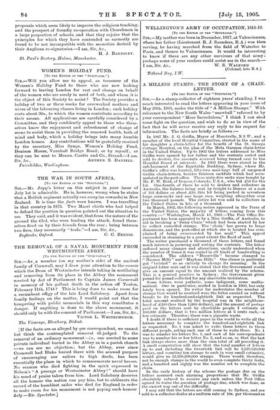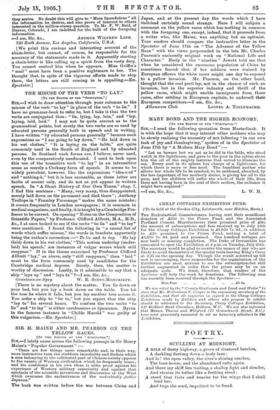LETTER.
Sin,—As a stamp-collector of eighteen years' standing. I was much interested to read the letters appearing in your issue of May 20th, 1905, under the title of "A Million Stamps." With reference to the New South Wales " snowball " referred to by your correspondent "More Incredulous," I think I can shed some light on the question, and wish to do so in view of the fact that he will never receive any reply to his request for information. The facts are briefly as follows:— In 1897 Mr. J. G. Griffin, Mayor of Hurstville, N.S.W., and a member of the local Hospital Committee, started in the name of
his daughter a chain-letter for the benefit of the St. George
Cottage Hospital, on the plan of the Meta Garman chain-letter in the United States. Up to 1902 the letters addressed to, Miss
Griffin were opened by her father and the contents sorted and sold to dealers, the amounts received being turned over to the Hospital Board at intervals. In 1902 there were stored in the sub-basement of the Equitable Building Sydney, where Mr.
Griffin's office was located, fifty-two wail-bags full of unopened Griffin chain-letters, besides thirteen sackfuls which had accu-
mulated in the post-office. These sixty-five sacks were bought by Mr. F. W. Reid, of Denver, Colorado, U.S.A., who bid 253 for the lot. One-fourth of these he sold to dealers and collectors in Australia, the balance being sent by freight to Denver at a cost of 101 dollars or about 420, this kt being packed in seventeen large corn-sacks and one large case, weighing altogether over two thousand pounds. The entire lot was sold to collectors in the United States In lots of a thousand.
In March, 1902, the following notice appeared in the Press of the United States, the majority of letters coming from this country :—" Washington, March 13, 1902.—The Post Office De- partment has been appealed to by a Miss Griffin, of Australia, to aid in breaking a 'Daisy Chain' which had been started by her to collect cancelled stamps. The • chain' has grown to• large dimensions, and the post-office at which she is located has com- plained of being overcrowded by her mail." This appeal succeeded in stemming to a great extent the flood of mail.
The writer purchased a thousand of these letters, and found much interest in perusing and sorting the contents. The letter suffered many changes and alterations, easily understood when the number of times it was copied in all kinds of handwriting is considered. The address "Hurstville " became changed to "Magner Mills" and " Maylone Hills." One clause in particular got "twisted" so as entirely to change its meaning. In the original letter sent out it was stated that the Government would give an amount equal to the amount realised by the scheme. This is a general practice in Sydney ; the Government gives pound for pound collected for any charitable institution. Some letters were pathetic, some indignant, some mathe- matical. One in particular, mailed in London in 1900, has only lately been opened. Its writer far understates the number of stamps that would be received were the letter carried on without breaks to its hundred-and-eightieth link as requested. The total amount realised by the hospital was in the neighbour- hood of 2200 (less than 1,000 dollars), and the amount of postage paid on tho letters sent by charitable people I estimate at 100,000 dollars ; that is two million letters at 5 cents each,—a low estimate. Therefore there was a gigantic waste.
I doubt if there is sufficient paper in the world to write all the letters necessary to complete the hundred-and-eightieth link as requested. No. 1 was asked to write three letters to three different people, asking each one of these to write three. No. 1 was to number his letters No. 7, and each of his correspondents was to number his or her letter No. 2, and so on, so that the last link always shows more than the sum total of• all preceding it. A small computation will show that the total number of letters up to and including the twentieth link will be 5,229,520,800 letters, and counting ten stamps to each (a very small estimate), would give us 52,295,208,000 stamps. There would, therefore, not be enough stamps in the world to even complete thirty links, and a hundred and eighty was the number set to complete tho chain.
In the early history of the scheme the postage due on the letters assumed such alarming proportions that Mr. Griffin absolutely refused to receive any such unless the Post Office agreed to waive the question of postage due, which was done, as the easiest way out of the difficulty.
I may add that the letters are still coming to Sydney, and are sold to a collector-dealer at a uniform rate of 10s. per thousand as
they arrive. No doubt this will give to "More Incredulous" all the information he desires, and also prove of interest to others interested in the million-stamp question. To Mr. F. W. Reid, of Denver, Colorado, I am indebted for the bulk of the foregoing information.
• I am, Sir, &c., ARTHUR WILFRED LINE.
730 Ruth Avenue, Los Angeles, California, U.S.A.
[We print this curious and interesting account of the chain-letter, but cannot, of course, be responsible for the accuracy of the statements made in it. Apparently starting a chain-letter is like calling up a spirit from the vasty deep. You cannot control him when he appears. Miss Griffin's "mail" must have been a positive nightmare to her. The thought that, in spite of the vigorous efforts made to stop them, the letters are still coming in is appalling.—ED. Spectator.] THE MISUSE OF THE VERB "TO LAY."







































 Previous page
Previous page